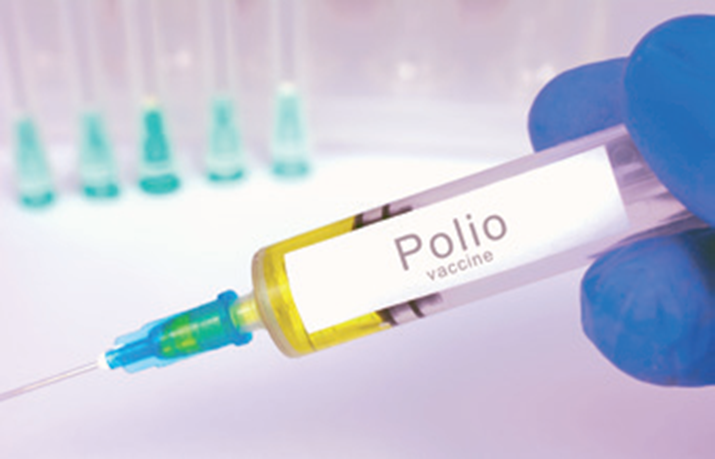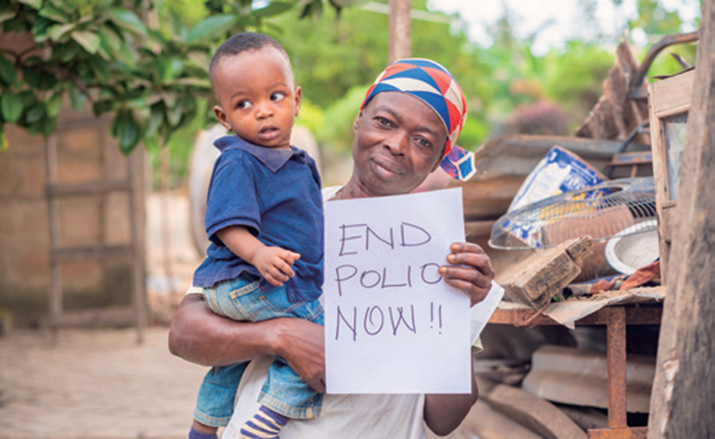| Global Views on Fighting COVID-19 |
| A polio-free Africa can help spur economic growth and development | |
| The expertise gained from polio eradication will continue to assist the African region in tackling COVID-19 and other health problems that have plagued the continent for so many years and ultimately move the continent toward universal health coverage. This will be the true legacy of polio eradication in Africa | |
|
|
 The success of the polio eradication efforts in Africa can be attributed to vaccination efforts that have so far reached every child in every remote community (HELLORFF)
A complete state of physical, mental and spiritual well-being has always been the quest for humankind. Part of this balance includes the absence of illness and disease. In fact, peoples' health has a direct bearing on economic growth and development of a nation.
There is no doubt that Africa has traditionally borne a heavy disease burden, which is a major source of its economic weakness. So, in late August, the declaration by the independent Africa Regional Certification Commission for Polio Eradication that the World Health Organization (WHO) African Region is free of wild poliovirus was met with much jubilation. The WHO says the news marks the eradication of the second virus from the face of the continent since smallpox 40 years ago. The campaign to make the continent polio-free began in 1996, when African heads of state made the commitment to eradicate the disease during the 32nd Ordinary Session of the Organization of African Unity (precursor of the African Union) in Yaoundé, Cameroon. Polio was paralyzing an estimated 75,000 children annually on the African continent, says the WHO. Today, only Pakistan and Afghanistan are still reporting wild poliovirus. The Africa Centers for Disease Control and Prevention defines polio as a disabling and life-threatening disease, caused by the poliovirus, that can lead to permanent paralysis of various body parts and may ultimately cause death by immobilizing the patient's breathing muscles. The poliovirus spreads from one person to another and can infect a person's spinal cord resulting in paralysis. Polio is transmitted substantially through contaminated water, food or contact with an infected person. Combined efforts While there is no cure for polio, presently, there are two vaccines that protect children from polio for life - oral polio vaccine (OPV) and inactivated poliovirus vaccine (IPV). OPV is administered orally, providing protection in the mouth, intestines and in the blood, while IPV is an injectable vaccine that provides protection in the blood. The August confirmation by the WHO that no African child was infected by poliovirus in the last three years, saving nearly 225,000 African children, shows the fight against the disease was bearing fruit and the returns were visible. The eradication of polio in Africa has been a long and arduous voyage. In the mid-1970s, only a few countries recorded immunization activities and by that time, cases of polio in Africa passed the 168,000 mark - a figure that was higher than earlier estimates. In 1988, the fight for eradication of polio was gaining momentum and the World Health Assembly adopted a resolution for the worldwide eradication of polio. The war against polio then took off, marking the launch of the Global Polio Eradication Initiative. This multi-stakeholder initiative was spearheaded by the WHO, Rotary International, national governments, the U.S. Centers for Disease Control and Prevention, UNICEF, the Bill & Melinda Gates Foundation, and Gavi, the Vaccine Alliance. According to the WHO, this initiative has decreased wild polio cases by over 99 percent since 1988, from an estimated 350,000 cases in more than 125 endemic countries to 175 reported cases in 2019. The poliovirus infections impacted all countries across Africa, paralyzing more than 75,000 children in 1995. It was worsened by conflicts and political instability in some parts of the continent. This triggered a new campaign in 1996, spearheaded by former South African President Nelson Mandela, dubbed "Kick Polio Out of Africa." The main objective of the initiative was to ensure that children below the age of five were vaccinated. In 2000, the campaigns for kicking polio out of Africa continued in earnest in 17 countries, with 76 million children being inoculated by an army of volunteers. The vaccination efforts expanded to 24 countries, mostly in West and Central Africa, where an outbreak was causing havoc. This initiative led to a large-scale, multi-national vaccination of 85 million children.  Polio is officially declared eradicated from the African continent by the WHO on August 25 (HELLORF)
Far-reaching vaccination campaign The success of the polio eradication efforts in Africa can be attributed to vaccination efforts that have so far reached every child in every remote community. The strengthening of disease surveillance and laboratory networks in Africa has also bolstered polio eradication efforts by building a robust and sensitive epidemiological surveillance system, with a network of well-equipped laboratories and thousands of specially trained personnel who were the continent's frontline workers. The concerted efforts reached communities through social mobilization and communication networks, making it possible for marginalized and conflict communities to be reached. This way, polio programs faced less resistance and became widely accepted. The continent's success in the fight against polio is also attributed to the improved outbreak response capacity supported by the WHO and other partners involved in emergency responses. The polio team's huge network of community volunteers, health workers, communication experts, and surveillance and logistics teams played a major role in dispelling rumors and misinformation about polio vaccination drives. While significant strides were made in overcoming the polio outbreak, numerous challenges such as insecurity, conflicts, wars, weak health systems and poor sanitation slowed down the eradication efforts. In 1999, former UN Secretary General Kofi Annan negotiated a ceasefire between the Government of the Democratic Republic of the Congo and rebel forces to allow for national immunization campaigns across the country. Political instabilities exacerbated the problem leading to full blown polio outbreaks in some parts of Africa. This is why in curbing polio and other infectious diseases the AU has been steadfast in silencing the guns, to create a conducive environment for socio-economic development. Matshidiso Moeti, WHO Regional Director for Africa, has said that the challenge now remains with African governments to reallocate new commitments and resources to build on this legacy and to ensure that efforts to fully eradicate polio from Africa are not lost, but instead used to strengthen public health systems for generations to come. "The expertise gained from polio eradication will continue to assist the African region in tackling COVID-19 and other health problems that have plagued the continent for so many years and ultimately move the continent toward universal health coverage. This will be the true legacy of polio eradication in Africa," said Moeti.
The writer is an economist, consultant and a regional commentator on trade and investment based in Nairobi, Kenya (Print Edition Title: Shutting Polio Door) Comments to zanjifang@chinafrica.cn |
|
||||||||||||||||||||||||||||||
|
